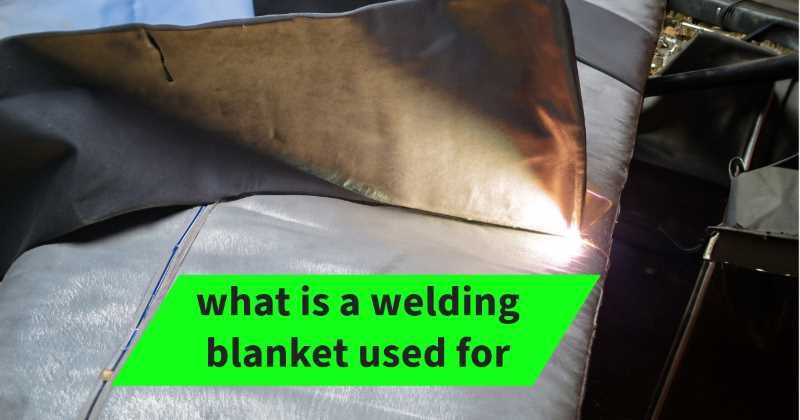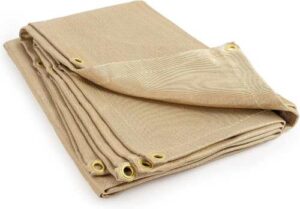Table of Contents
- What is a Welding Blanket Used For?
- Protecting Workspaces and Equipment
- Fire Prevention and Safety
- Personal Protection
- Hot Work Operations
- Stress Relief and Welding Distortion Prevention
- Pipe Welding and Maintenance
- Automotive Repair and Maintenance
- Shipbuilding and Marine Repairs
- Construction and Infrastructure Development
- Aerospace and Aviation Industry
- HVAC System Maintenance
- Forge Welding and Blacksmithing
- Do You Really Need a Welding Blanket? Unveiling the Essentials
- Exploring the Need for Welding Blankets
- Fire Blanket vs. Welding Blanket: Clearing the Confusion
- The Safety of Welding Blankets
- Addressing Waterproofing Concerns
- Factors Affecting the Resistance of Welding Blankets
- Exploring Different Coating Types
- Diverse Varieties of Welding Blankets
- Choosing the Best Welding Blanket for Home Welding
- Maintaining and Cleaning Your Welding Blanket
- 🔥 Revealing Welding Blanket Secrets: Your Burning FAQs Answered!
- Conclusion
Welding is a crucial industrial process that involves melting metal pieces to create a strong bond. While it’s essential for various construction and manufacturing applications, it also poses several hazards due to extreme heat, sparks, and potential splatter. To address these safety concerns and improve work efficiency, welding blankets are widely used. In this article, we will delve into the details of what welding blankets are used for and how they contribute to maintaining a safe and productive welding environment.
What is a Welding Blanket Used For?
A welding blanket is a heavy-duty protective cloth designed to shield workers, equipment, and surroundings from the intense heat, sparks, and potential splatter generated during welding operations. These blankets are woven from heat-resistant materials, making them ideal for various applications across industries. Let’s explore some of the key applications where welding blankets are used:
Protecting Workspaces and Equipment
Welding generates extreme heat and sparks that can cause damage to surrounding equipment, surfaces, and structures. Welding blankets act as a barrier, preventing sparks and splatter from reaching sensitive areas and causing accidents or fires. They are often used to cover nearby machinery, tools, and surfaces that need protection.
Fire Prevention and Safety
Fire hazards are prevalent in welding environments due to the combination of high temperatures and flammable materials. Welding blankets are crucial in preventing fires by containing sparks and minimizing the risk of ignition. They create a safe zone around the welding area, reducing the chances of fire-related accidents.
Personal Protection
Welding operators are at risk of burns and other injuries due to exposure to extreme heat and flying debris. Welding blankets can be worn as personal protective gear to shield the welder from sparks and radiant heat. This additional layer of protection enhances the safety of welders, allowing them to work with confidence.
Hot Work Operations
In industries where hot work operations are common, such as metal fabrication and shipbuilding, welding blankets are indispensable. They offer a convenient and effective way to protect surfaces, materials, and personnel from the heat generated by various processes like welding, cutting, and brazing.
Stress Relief and Welding Distortion Prevention
During welding, metals undergo thermal expansion and contraction, which can result in stress and distortion. Welding blankets can be strategically positioned to control the rate of cooling and minimize stress, leading to better weld quality and reduced distortion.
Pipe Welding and Maintenance
Pipe welding involves intricate operations that require precise control over the welding environment. Welding blankets are used to enclose the work area and maintain consistent heat levels. This prevents the cooling of pipes during welding, ensuring strong, durable welds.
Automotive Repair and Maintenance
Welding blankets find applications in the automotive industry for repair and maintenance tasks. When working on vehicles, welding blankets protect sensitive components, interiors, and electronics from heat and sparks, maintaining the integrity of the vehicle.
Shipbuilding and Marine Repairs
In shipbuilding and marine repair projects, welding blankets are used to create safe zones for welding and cutting. They safeguard the ship’s surfaces and equipment from heat and sparks, contributing to the overall safety and quality of the construction process.
Construction and Infrastructure Development
Welding blankets play a vital role in construction and infrastructure projects. They are used to protect adjacent structures, materials, and surfaces during welding operations. This prevents any damage that could compromise the structural integrity of the project.
Aerospace and Aviation Industry
In aerospace and aviation applications, where precision and safety are paramount, welding blankets are used to shield critical components from heat and sparks. This ensures that the structural integrity and functionality of aircraft components are not compromised.
HVAC System Maintenance
During maintenance and repair of heating, ventilation, and air conditioning (HVAC) systems, welding blankets are used to protect sensitive components and surrounding areas from heat and potential damage.
Forge Welding and Blacksmithing
Forge welding and blacksmithing involve high temperatures and intricate processes. Welding blankets are employed to manage heat distribution and prevent unwanted distortion, resulting in high-quality, visually appealing metalwork.
Do You Really Need a Welding Blanket? Unveiling the Essentials
Exploring the Need for Welding Blankets
When engaging in welding tasks, ensuring safety should be your utmost priority. One essential tool that often arises in discussions about welding safety is the welding blanket. But do you really need one? Let’s delve into the reasons why welding blankets are a crucial asset for your welding endeavors.
Protection Against Heat and Sparks
Welding operations generate intense heat and spark that can pose serious risks to your surroundings. A welding blanket acts as a protective barrier, preventing these sparks from igniting nearby flammable materials or causing accidents. By using a welding blanket, you can significantly reduce the chances of fire outbreaks and ensure a safer working environment.
Minimizing Welding Splatter Impact
Molten metal splatter is a common byproduct of welding that can cause damage to nearby surfaces, equipment, and even individuals. Welding blankets are designed to intercept and absorb these splatters, effectively minimizing their impact. With a welding blanket in place, you can protect sensitive machinery and maintain the integrity of your workspace.
Containment of Harmful Emissions
Certain welding processes release harmful fumes, gases, and particles into the air. Welding blankets can be utilized to contain and redirect these emissions, reducing their dispersion and safeguarding the respiratory health of both workers and the environment. This additional benefit highlights the holistic safety approach that welding blankets offer.
Fire Blanket vs. Welding Blanket: Clearing the Confusion
Fire Blanket:
A fire blanket is primarily designed for extinguishing fires involving small flames or clothing that has caught fire. It is made from fire-resistant materials and is used by wrapping it around a person or object on fire to smother the flames and cut off the oxygen supply.
Welding Blanket:
On the other hand, a welding blanket is specifically engineered to protect against the intense heat, sparks, and molten metal splatter produced during welding processes. It acts as a heat shield and containment barrier, preventing fires and providing a safe environment for welders and their surroundings.
The Safety of Welding Blankets
Welding blankets are indeed safe when used according to their intended purpose. These blankets are manufactured from fire-resistant materials, making them highly effective at shielding against heat and sparks. However, as with any safety equipment, proper usage and adherence to manufacturer guidelines are crucial for ensuring their effectiveness.
Addressing Waterproofing Concerns
Welding blankets are not typically designed to be waterproof. Their main focus is on heat resistance and protection against sparks and splatters. If you require waterproofing in your welding environment, it’s advisable to explore additional safety measures or equipment that cater specifically to that need.
Factors Affecting the Resistance of Welding Blankets
The resistance of a welding blanket depends on several key factors, including the type of material used, the thickness of the blanket, and the presence of any specialized coatings. These factors collectively determine the blanket’s ability to withstand high temperatures and protect against heat transfer.
Exploring Different Coating Types
Welding blankets often come with various coatings that enhance their performance. Coatings can include materials like vermiculite, silicone, and heat-reflective compounds. These coatings contribute to the blanket’s fire resistance, thermal insulation, and overall durability.
Diverse Varieties of Welding Blankets
There is a wide range of welding blankets available, each designed for specific welding applications. Some blankets are intended for heavy-duty industrial use, while others are tailored for lighter DIY projects. Welding blankets may vary in size, material composition, and heat tolerance, allowing welders to choose the most suitable option for their needs.
Choosing the Best Welding Blanket for Home Welding
For those engaging in welding projects at home, selecting the right welding blanket is essential. A blanket with proper insulation, fire resistance, and size will ensure a safe and productive welding experience. Look for blankets that are easy to handle and store, as well as ones that meet the requirements of your particular welding tasks.
Maintaining and Cleaning Your Welding Blanket
To prolong the lifespan of your welding blanket and maintain its protective qualities, regular cleaning and maintenance are necessary. Follow the manufacturer’s guidelines for cleaning, which often involve brushing off debris, washing with mild detergents, and avoiding abrasive cleaning methods.
🔥 Revealing Welding Blanket Secrets: Your Burning FAQs Answered!
Q: Can welding blankets withstand extremely high temperatures?
A: Yes, welding blankets are designed to handle high temperatures, often reaching up to 3000°F or more. They are made from specialized heat-resistant materials that ensure effective protection.
Q: Are welding blankets reusable?
A: Yes, many welding blankets are reusable and can withstand multiple welding operations. Regular maintenance and proper storage can extend their lifespan.
Q: How do I clean welding blankets?
A: Cleaning methods vary based on the blanket’s material. Some can be shaken or brushed to remove debris, while others can be machine-washed or wiped down. Always refer to the manufacturer’s guidelines.
Q: Can I use welding blankets for other applications?
A: While welding blankets are primarily designed for welding operations, they can also be used for tasks involving heat, sparks, and fire protection, making them versatile safety tools.
Q: Are welding blankets suitable for outdoor use?
A: Yes, many welding blankets are suitable for outdoor use. However, it’s essential to choose blankets specifically designed for outdoor applications to ensure maximum durability.
Q: How do welding blankets enhance safety?
A: Welding blankets create a protective barrier that prevents sparks and heat from causing fires, burns, and damage. They contribute significantly to maintaining a safe working environment.
Conclusion
Welding blankets are versatile tools with a wide range of applications across various industries. From protecting equipment and workspaces to enhancing personal safety, these blankets are essential for maintaining a secure and productive welding environment. By understanding the diverse ways in which welding blankets are used, industries can ensure the safety of workers, equipment, and valuable structures. Whether in construction, manufacturing, or specialized fields like aviation, welding blankets play a pivotal role in preventing hazards and ensuring successful welding operations.


1 thought on “Unlocking Welding Blanket Secrets: Must-Know Uses!”